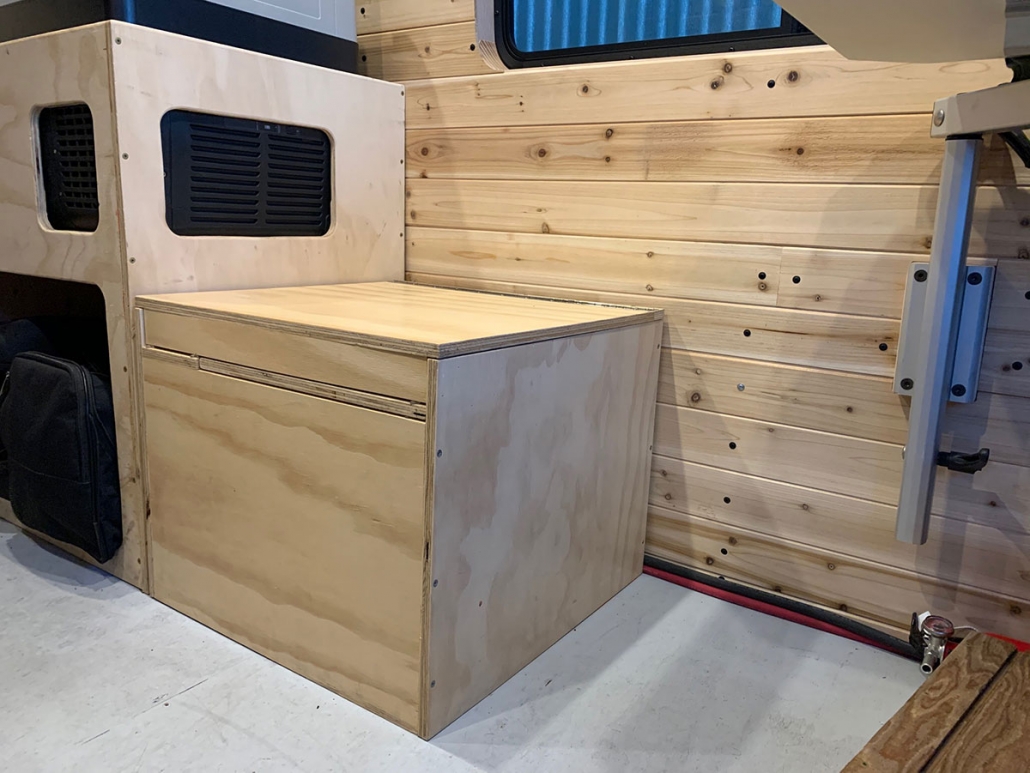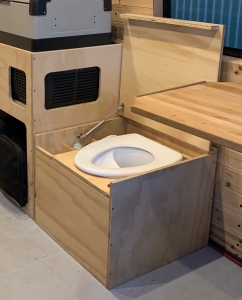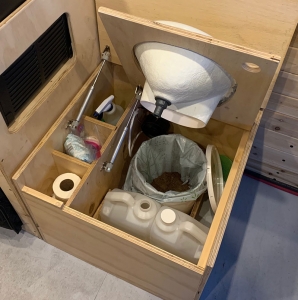Here we are, finally on our adventure of a lifetime, living in a van. It is Amazing!!
But how DO we manage our delicate routines (going to the bathroom, using the head, visiting the loo, copping a squat, pinching a loaf, taking the browns to the super bowl – you get what I’m layin’ down) with one another in this tight space? This usually private event is now unfortunately shared with my best friend and most intimate partner. However, it is our new reality.
 This post contains affiliate links. We may earn compensation when you click on the links at no additional cost to you.
This post contains affiliate links. We may earn compensation when you click on the links at no additional cost to you.
Our set up is a plywood box that conceals our composting toilet. It doubles as a chair when the lid is down. (We owe a big thank you to “Create Wondr” for the inspiration and their how-to video. For a non-construction person like me, it was huge to try to wrap my head around designing it.) There are so many things to consider when building something; it took a good portion of my morning just to figure out the dimensions of the unit.
NOTICE: We have completed a set of plans for you to build your own composting toilet just like this. They are available FREE for download at this link.
The outside of the box, if you will, was the easiest part to come up with. Our composting toilet has 3 layers; the lid that covers the top is the top layer and is the chair portion.
 Lift that up and there’s the toilet seat with a urine diverter, that’s the second layer.
Lift that up and there’s the toilet seat with a urine diverter, that’s the second layer.
Under that is the third or bottom layer that holds the bucket in the back for solids, 2 plastic gallon jugs closer to the front for liquids, and 3 side compartments for storage.
(and both of these hinged parts stay open with these struts)
We use the storage compartments for unused toilet paper, a plastic bag for used toilet paper and a bag of composting material for the solids.
The bucket and jugs need to be in the correct location under the seat, so the construction bracing for the box doubles to keep them in place so they fit perfectly and all liquids and solids fall into their intended places.
 It’s easy getting liquids into the jug when you have a urine diverter. It’s also easy to monitor how much urine is in the jugs because they are translucent. That becomes important when they start getting full. We’ve come up with a routine where we switch jugs just before bedtime to prevent any mishaps or overage problems. When it is time we dump them at a roadside rest stop, pit toilet, or public bathroom.
It’s easy getting liquids into the jug when you have a urine diverter. It’s also easy to monitor how much urine is in the jugs because they are translucent. That becomes important when they start getting full. We’ve come up with a routine where we switch jugs just before bedtime to prevent any mishaps or overage problems. When it is time we dump them at a roadside rest stop, pit toilet, or public bathroom.
I recently read a blog post at Live Small Ride Free that calculated how much water we are saving by urinating into a jug instead of a toilet bowl full of water. That post does a great job describing the do’s and dont’s of where to deposit your waste so I won’t go into that here.
My personal challenge has been making solids hit the spot. I mean let’s be honest, I’ve not had to think about that before because everything goes into one place when you sit on a conventional toilet, but with my anatomy being so close together, separating the two is something I’ve needed to practice.
For some reason the process of depositing solids is a little harder to share while in certain company. Pooping has been a solo activity since I was out of diapers. I avoided it in the beginning but at some point it became necessary to get over it and just go. It’s a normal part of life after all. But still, if the timing is right and I am able to use a public restroom I will.
Our set up has an electric fan down by the bucket that fits into an outside vent made from a PVC Pipe Reducer and a short length of pipe that takes care of any smell that may emit from our production. Check out this video we made:
Once you’ve made a deposit, the next step is to make sure it’s covered with something. (We originally used peat moss, but from a number of comments on our YouTube channel, we learned that peat moss is not a very sustainable option, so we’ve now switched to wood shavings from the pet store, like the kind you’d put in a hamster cage.)
I realize it seems unsanitary but it really isn’t. It’s all organic. Just wash your hands afterwards like you’ve always done after using the bathroom. There just isn’t any water so the sounds are different. The used tissue goes into a plastic (reusable) bag that we empty into the trash when it gets full. (This is because composting toilets don’t like toilet paper) The house I grew up in had a finicky septic system and we were never allowed to throw toilet paper in the toilet bowl anyway. Bad for the septic, you know. So I am familiar with this part and it doesn’t bother me.
We occasionally “flush” our urine compartment of the diverter with water from a spray bottle and we rinse our pee jugs about once a week. We use a plastic bag to line our solids bucket. I know, I know – I am against plastic too, but it makes disposal of such things so much easier and kinder for everyone. The final product gets thrown in the trash. (refer to blog post mentioned earlier)
I think I’ve covered all the questions I had when we first started this van adventure but if you have any please comment on this blog post and I will hopefully be able to answer them for you.

3 thoughts on “Liquids and Solids”
Where did you get your diverter for under the seat please?
Hi Patrick – Thanks for your comment! It’s linked on the blog post. But if you missed it, it was Ebay at this link: https://www.ebay.com/itm/urine-diverter-For-Males-To-Stand-Up-for-eco-compost-toilet-separator/143166355400
Amazon sells biodegradable trash bags in various sizes, even doggie size. They can make our “bag of sh**” lifestyle even more ecologically proper.